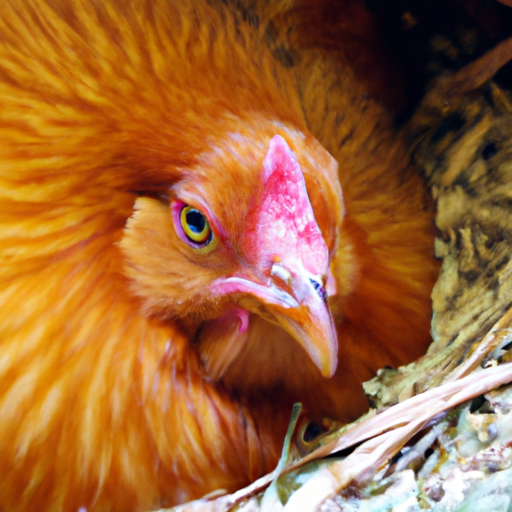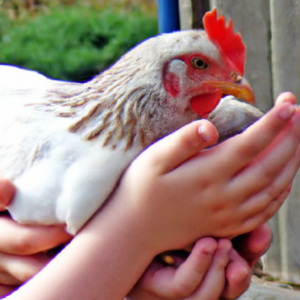
Have you ever had chickens that just won’t leave their eggs, no matter what you try? Dealing with consistently broody chickens can be a challenge for any backyard poultry enthusiast. Whether you’re an experienced chicken keeper or just starting out, finding the best way to address this issue is essential for ensuring your flock’s health and productivity. In this article, we will explore some effective strategies and tips to help you handle broody chickens and maintain a happy and thriving flock. So, let’s get started and find the solution to your broody chicken dilemma!
Understanding Broody Chickens
Broodiness in chickens refers to their instinct to incubate eggs and raise chicks. This behavior is characterized by a hen’s refusal to leave the nest, puffed out feathers, and an intense desire to sit on eggs. Understanding broodiness is crucial for poultry farmers as it can have significant implications on egg production, hen health, and overall flock management.
Definition of broodiness
Broodiness is a natural instinct in female chickens, typically triggered by hormonal changes and environmental factors. It is the hen’s way of preparing to reproduce by maintaining the appropriate conditions for egg incubation and chick rearing. During this period, she becomes less interested in laying eggs and focuses on creating a warm and safe environment.
Causes of broodiness
Broodiness can be influenced by various factors, including genetics, breed, age, and the presence of a rooster. Certain chicken breeds are more prone to broodiness than others, such as Silkies and Cochins. Hormonal fluctuations, especially during the springtime, can also trigger broodiness in hens. Additionally, environmental factors such as the availability of nesting areas and the presence of other broody hens can contribute to the onset of broodiness.
Identifying broody behavior
Identifying broody behavior is essential for effectively managing broody chickens. When a hen becomes broody, she will spend extended periods of time in the nest, refusing to leave even for food and water. She may exhibit puffed out feathers to cover the eggs and may become more territorial and defensive. Hens may also emit specific vocalizations and exhibit a characteristic “broody cluck.” Observing these behaviors can help identify broodiness in chickens and allow for appropriate intervention.
Potential Issues with Broody Chickens
While broodiness is a natural behavior, it can pose several challenges for poultry farmers and impact overall flock management.
Impact on egg production
One significant issue with broody hens is their impact on egg production. During periods of broodiness, hens will cease laying eggs and instead focus on incubating the eggs already laid. This can lead to reduced egg production and potentially affect the farm’s profitability. Consistently broody chickens can disrupt the regular egg-laying cycle, causing delays in egg collection and a shortage of eggs for sale.
Health risks for broody hens
Broodiness can also pose health risks for the hens themselves. The extended periods of inactivity and time spent on the nest can lead to weight loss, dehydration, and malnutrition. Broody hens may neglect their own needs, including proper nutrition and hygiene, which can make them more susceptible to diseases and parasitic infestations. Additionally, brooding for extended periods can cause muscle and bone degeneration in hens.
Behavioral issues in broody chickens
Broody hens may exhibit behavioral changes that can disrupt flock dynamics. They can become more aggressive and territorial, especially when defending their nest and eggs. This aggression can lead to conflicts with other hens, potentially resulting in injuries or reduced social harmony within the flock. Broody behavior can also impact rooster behavior, as they may become more protective and assertive around the brooding hen.
Natural Methods to Break Broodiness
When dealing with broody chickens, many poultry farmers prefer natural methods to break broodiness before considering more drastic interventions.
Allowing natural incubation
One approach is to allow the broody hen to naturally incubate a small clutch of eggs. This satisfies her instinct and can help break the broody cycle. However, it is important to monitor the hen closely during this process to ensure her health and well-being. Once the chicks hatch, they can be separated from the broody hen to avoid perpetuating broodiness.
Providing distraction and environmental changes
Distraction techniques can be effective in redirecting the hen’s focus and breaking the broody behavior. By providing environmental changes in the coop, such as rearranging nesting areas, adding different materials, or introducing new surroundings, the hen’s attention can be diverted. Offering treats or providing additional stimulation through foraging can also help occupy the broody hen’s time.
Limiting access to nesting areas
Restricting access to nesting areas can discourage broody behavior. By blocking off nests or making them less enticing, such as by removing bedding or eggs, the hen may lose interest in remaining there. This method encourages the hen to explore other areas of the coop and engage in more activity, reducing the intensity of broodiness.
Physical Intervention and Techniques
If natural methods fail to break broodiness, physical interventions can be employed to discourage the behavior.
Removing or isolating broody hens
Removing broody hens from the nest and isolating them in a separate space can help disrupt the brooding cycle. This separation removes the stimuli that trigger broodiness and can gradually discourage the behavior. The isolation area should be well-ventilated, with access to food and water, but without nesting materials.
Using a wire cage or broody coop
Another physical intervention method is using a wire cage or broody coop specifically designed for breaking broodiness. These enclosures provide limited space, eliminating the possibility of nest building and egg incubation. The wire mesh also discourages the instinct to sit on eggs by preventing access to them.
Applying cooling techniques
Cooling the broody hen’s body temperature can help break broodiness. This can be done by gently spraying or misting the hen with cool water, as well as ensuring good ventilation in the coop. Cooling the hen simulates unfavorable conditions for egg incubation, making her less inclined to remain broody.
Egg Collection and Management
Proper egg collection and management techniques can help prevent and manage broodiness in chickens.
Frequent egg collection
Regular and timely egg collection is essential to discourage broodiness. Leaving eggs in the nest for extended periods can trigger a hen’s instinct to incubate them. By collecting eggs frequently, ideally multiple times a day, you can minimize the number of eggs available for brooding and reduce the chances of broodiness.
Replacing eggs with dummy or infertile eggs
Replacing viable eggs with dummy or infertile eggs can also discourage broodiness. Hens are less likely to invest energy in incubating eggs that will not hatch. Dummy eggs made of non-edible materials or infertile eggs can be swapped for viable eggs when collecting them from the nest.
Disrupting the nest
Disrupting the nest by rearranging nesting materials, removing bedding, or altering the nest’s physical structure can discourage broody behavior. The hen may become disoriented and lose interest in the nest, redirecting her focus away from brooding. It is important to be gentle when performing nest disruptions to avoid causing unnecessary stress to the hen.
Utilizing Artificial Lighting
Artificial lighting can be a useful tool in managing broody behavior in chickens.
Adjusting light exposure
Manipulating the light exposure in the coop can affect a hen’s reproductive cycle. Increasing the amount of light during the day and decreasing darkness periods can suppress broodiness. Providing approximately 14-16 hours of light per day can help regulate hormone levels and discourage broodiness in chickens.
Extended daylight or darkness periods
Implementing extended daylight or darkness periods can also impact broodiness. Gradually increasing the length of daylight hours can mimic the natural hormonal changes during the spring, which can reduce or prevent broodiness. Conversely, exposing hens to extended darkness periods can disrupt their internal clock, minimizing broody behavior.
Effectiveness of using artificial lighting
While artificial lighting can be effective in managing broodiness, it is important to ensure the chickens have access to natural light as well. The aim is to provide a balanced light environment that mimics natural daylight patterns. Consulting with poultry experts or experienced farmers can help determine the optimal lighting schedules for managing broodiness effectively.
Genetic Selection and Breeding
Genetics plays a significant role in a chicken’s propensity for broodiness. Selecting broody-resistant chicken breeds and utilizing selective breeding techniques can help minimize broodiness in your flock.
Choosing broody-resistant chicken breeds
When building a flock, consider selecting chicken breeds that are known to be less prone to broodiness. Breeds like Leghorns and Easter Eggers tend to have lower broodiness tendencies and are more focused on consistent egg production. However, it is essential to strike a balance between broodiness tendencies and other desirable traits, such as docility or meat quality.
Selective breeding for reduced broodiness
If you plan to breed chickens, consider incorporating selective breeding techniques to reduce broodiness over generations. By choosing breeding pairs that exhibit lower broodiness tendencies, you can gradually develop a brood-resistant lineage within your flock. Consulting with experienced poultry breeders or breed associations can provide valuable guidance on selective breeding methods.
Consulting with poultry experts or breeders
Seeking advice from poultry experts or experienced breeders is crucial when selecting and breeding hens. They can provide insights on specific breed characteristics, broodiness tendencies, and optimal breeding practices for broodiness reduction. Their expertise can be invaluable in establishing a healthy and productive flock.
Nutritional Considerations
Proper nutrition plays a vital role in managing broodiness in chickens. Ensuring a balanced diet and providing essential nutrients can help reduce broodiness tendencies.
Balanced diet for broodiness prevention
Feeding chickens a balanced diet that meets their nutritional requirements is essential for overall flock health and can help prevent broodiness. A diet rich in high-quality proteins, vitamins, and minerals can regulate hormone levels and discourage excessive broodiness. Consult with a poultry nutritionist or veterinarian to determine the most appropriate feed for your flock.
Increasing protein intake
Increasing protein intake in the diet can help reduce broodiness in chickens. Protein is essential for hormone regulation and overall reproductive health. Including protein-rich feed sources, such as soybean meal or fishmeal, can potentially deter broodiness and encourage consistent egg production.
Supplementing with vitamins and minerals
Supplementing the diet with appropriate vitamins and minerals can have a positive impact on broodiness management. Vitamin and mineral deficiencies can disrupt hormone levels and reproductive cycles, potentially leading to increased broody behavior. Consult with a poultry nutritionist to determine the specific vitamin and mineral requirements for broody hens.
Alternative Approaches to Broody Chickens
In some cases, alternative approaches to broody behavior may be considered, depending on the farm’s specific goals and circumstances.
Utilizing broody hens for natural incubation
Broody behavior can be harnessed for natural incubation by allowing broody hens to hatch and raise chicks. This approach can be valuable for small-scale poultry operations aiming to expand their flock naturally. However, it requires meticulous attention to ensure the health and safety of both the broody hens and the chicks.
Allowing some broody behavior under controlled conditions
For poultry farmers who value the benefits of broody behavior, allowing controlled brooding can be an option. This involves selecting specific hens for broodiness and creating suitable conditions for their incubation and chick-rearing activities. By carefully managing the broody hens, farmers can benefit from natural incubation and fostering a self-sustaining flock.
Considering rehoming broody hens
If broodiness becomes a persistent issue that significantly impacts egg production and flock dynamics, rehoming broody hens may be a viable solution. Some hobbyists or homesteaders may be interested in acquiring broody hens for their personal breeding programs. Ethical rehoming can ensure a better quality of life for broody hens, allowing them to fulfill their natural instincts in a more suitable environment.
Seeking Professional Advice
When dealing with consistently broody chickens, seeking professional advice can provide valuable insights and guidance.
Consulting a veterinarian or poultry specialist
If broody behavior persists or if you encounter specific health concerns, consulting a veterinarian or poultry specialist is highly recommended. These professionals can conduct thorough examinations, provide accurate diagnoses, and propose targeted treatment plans. Their expertise and experience can help address individual flock issues and ensure the well-being of your chickens.
Attending workshops or poultry farming events
Attending workshops or poultry farming events can offer valuable learning opportunities. These events are often hosted by experts in the field and cover a range of topics related to chicken care, management, and broodiness. The chance to engage with knowledgeable individuals and learn from their experiences can greatly enhance your understanding of broody chickens and their management.
Joining online poultry communities for guidance
Participating in online poultry communities and forums provides a platform for poultry enthusiasts to share their experiences, seek advice, and learn from each other. Engaging with these communities can help you connect with like-minded individuals facing similar challenges with broody hens. By sharing and exchanging knowledge, you can gain practical tips, strategies, and support to effectively manage broodiness in your flock.
In conclusion, managing broodiness in chickens requires a comprehensive understanding of the behavior, its potential issues, and the available intervention techniques. By implementing natural methods, physical interventions, egg collection and management strategies, and considering alternative approaches, poultry farmers can effectively break broodiness and maintain a healthy and productive flock. Seeking professional advice and continuously learning from experts and fellow poultry enthusiasts ensures the best practices are implemented for the overall well-being and success of the flock. So, with the right knowledge and measures in place, you can successfully deal with consistently broody chickens and foster a thriving poultry operation.







